Abstract
In this study, we aimed to identify the time course effects of different intensities of static stretch (SST) (maximal intensity without pain vs. high-intensity with moderate pain) on flexibility. This study included 16 healthy students (8 men and 8 women) who performed 1) 5-minute SST at 100%, 2) 110%, and 3) 120% intensity, as well as 4) no stretching (control) in a random sequence on four separate days. Static passive torque (SPT), hamstring electromyography (EMG), and pain intensity were continuously recorded during SST. We assessed markers of stiffness, range of motion (ROM), and maximal dynamic passive torque (DPTmax) before SST and 0, 15, 30, 45, 60, 75, and 90 minutes after SST. Stiffness decreased and ROM and DPTmax increased significantly immediately after SST at the three different intensity levels (p < 0.05). The effects of SST at 120% intensity were stronger and lasted longer than the effects of SST at 110% and 100% intensity (stiffness: -17%, -9%, and -7%, respectively; ROM: 14%, 10%, and 6%, respectively; DPTmax: 15%, 15%, and 9%, respectively). SPT decreased after SST at all intensities (p < 0.05). SST at 120% intensity caused a significantly greater reduction in SPT than SST at 100% intensity (p < 0.05). Pain intensity and EMG activity increased immediately after the onset of SST at 120% intensity (p < 0.05), although these responses were attenuated over time. Stretching intensity significantly correlated with the degree of change in ROM and stiffness (p < 0.05). These results support our hypothesis that stretch-induced flexibility is amplified and prolonged with an increase in stretch intensity beyond the pain threshold. Additional studies with more participants and different demographics are necessary to examine the generalizability of these findings.
Key points.
This study evaluated the effect of different intensity levels of static stretching on flexibility.
Stiffness decreased, whereas ROM and DPTmax increased dose-dependently with stretching intensity.
Stretching intensity beyond the pain threshold resulted in improved flexibility.
Key words: Passive torque, stiffness, torque-angle curve, joint range of motion
Introduction
Muscle stretching can increase flexibility, as measured by joint range of motion (ROM), and decrease muscle-tendon unit stiffness (Behm and Chaouachi, 2011; McHugh and Cosgrave, 2010; Weppler and Magnusson, 2010). As such, it has been reported that less flexible muscles may be at a high risk of muscle injury (Watsford et al., 2010; Witvrouw et al., 2003). In particular, the hamstrings are susceptible to injury (Woods et al., 2004). Thus, the American College of Sports Medicine recommends non-painful static stretching for 15–30 seconds to increase flexibility (Thompson et al., 2010). However, a previous study showed that stretching the hamstrings for 20 seconds without pain only increased flexibility immediately after stretching (Matsuo et al., 2013). Similarly, the stretch-induced increase in flexibility of the plantar flexors lasted for only a few minutes to 1 hour in previous studies (Mizuno et al., 2012; Ryan et al., 2008a; Ryan et al., 2008b). Conversely, Power et al. (2004) demonstrated increased flexibility after static stretching for 2 hours. Hence, identifying the most effective stretching conditions to induce greater and longer increments in muscle flexibility is important.
It has been documented that high-intensity stretch with pain induces involuntary muscle contractions as part of the stretch reflex, resulting in unwanted effects (Anderson and Anderson, 2010; Apostolopoulos et al., 2015a; Thompson et al., 2010). However, a systematic review suggested that there is little published evidence to support this conclusion (Apostolopoulos et al., 2015b). In contrast, anecdotal evidence suggests that high-intensity stretch with pain can increase flexibility among athletes, such as gymnasts, dancers, and wrestlers, all of which require high-level flexibility. For example, previous studies have reported greater improvements in flexibility, as measured by ROM and stiffness, after high-intensity stretch of the hamstrings with pain than after maximal intensity stretch without pain (Kataura et al., 2017; Takeuchi and Nakamura 2020; Takeuchi et al., 2021a). Moreover, other previous studies have suggested that the magnitude of change in flexibility after stretching depends on the duration of stretching of the hamstrings and plantar flexors (Matsuo et al., 2013; Ryan et al., 2008a; Ryan et al., 2008b). Therefore, in contrast to the general theory, high-intensity and long-duration stretching (e.g., 5 minutes) with pain might be more effective for increasing flexibility than what is generally recommended.
An increase in ROM after stretching occurs due to a decrease in musculotendinous stiffness and an increase in stretch tolerance (Magnusson et al., 1996a; Mizuno et al., 2013; Weppler and Magnusson, 2010). McHugh et al. (1992) reported that the reduction in passive resistance during stretch with maximal tolerable pain was greater than that during stretch without pain. Changes in the musculotendinous stiffness of the hamstrings are mainly based on mechanical factors, such as viscoelasticity (Magnusson et al., 1995; Magnusson et al., 1996a; Magnusson et al., 1996b; Taylor et al., 1990); intramuscular connective tissues (Gajdosik, 2001; Magnusson et al., 1996b; Morse et al., 2008; Taylor et al., 1990); fascicle length (Fowles et al., 2000; McHugh and Nesse, 2008); and tendon compliance (Kubo et al., 2001). Therefore, stretch with maximal tolerable pain might cause a greater reduction in musculotendinous stiffness than stretch without pain as a result of greater stress relaxation. In terms of the change in stretch tolerance related to the pain threshold, it has been speculated that the sensation of pain changes more after high-intensity stretch with pain than after maximal stretch without pain (Blazevich et al., 2012; Laessoe and Voigt, 2004; Magnusson et al., 1996a; Weppler and Magnusson, 2010). Therefore, the outcomes of high-intensity stretch may differ to those of maximal stretch without pain.
Although several studies have investigated the effects of high-intensity static stretch, studies investigating the duration of these effects, otherwise known as the retention time, are limited. A few studies have been published on the hamstrings (Hatano et al., 2019) and the plantar flexors (Mizuno et al., 2012; Mizuno et al., 2013). Hatano et al. (2019) showed that the stiffness of the hamstrings after maximal stretch without pain returned to normal more rapidly (20 minutes) than ROM and stretch tolerance (more than 30 minutes). To our knowledge, only one study (Takeuchi et al., 2021b) has investigated the time course of changes in flexibility after high-intensity static stretch. This study reported that the changes in ROM, passive torque at end ROM, and stiffness continued for at least 20 minutes after high-intensity static stretch of the hamstrings. However, in that study, the measurement time points after stretching were limited to 10 and 20 minutes, so the effects for all outcomes did not disappear in protocol. Therefore, time course differences with intensity have not been sufficiently investigated. To examine the effects of high-intensity stretch of the hamstrings over time, measurements over a longer period of time are needed.
It is assumed that high-intensity stretch with pain increases ROM along with changes in stiffness and stretch tolerance. Namely, Kataura et al. (2017) and Takeuchi and Nakamura 2020, Takeuchi et al. (2021a) reported stronger effects on ROM and stiffness immediately after high-intensity stretch. In contrast, Santos et al. (2019) showed no benefit with high-intensity static stretch on ROM and passive torque. Despite previous studies reporting an acute effect of static stretch on flexibility, the effects of stretch intensity on flexibility have not been explicitly studied; such studies may reveal important factors for injury reduction. Furthermore, it is not clear when the effects of high-intensity static stretch on flexibility subside.
Therefore, in this study, we aimed to examine the dose-dependent effects of three incremental stretch intensities on the time course of changes in flexibility. We hypothesized that 1) ROM would improve and that this effect would last longer with high-intensity stretch with pain than with maximal intensity stretch without pain and 2) that greater changes in musculotendinous stiffness and stretch tolerance would contribute to greater changes in ROM after high-intensity stretch.
Methods
Participants
Sixteen college students (8 men and 8 women) were recruited. The purpose of this study was described to the participants, who voluntarily provided written informed consent. The study was conducted in accordance with the Declaration of Helsinki and was approved by the Nagoya University School of Health Sciences Human Research Ethics Committee (approval number: 12-511). The exclusion criteria were as follows: 1) lower-extremity contracture, 2) a history of lower-extremity or back surgery, 3) neurological disorders, 4) hyper-extension of the knee (too flexible) in the position used in this study, and 5) participation in competitive sports or aerobic, resistance, or flexibility training within the preceding 6 months. The most active participants performed recreational activities two times per week, but the other participants undertook recreational activities ≤ once per week. The mean (± standard deviation) age, height, and body mass values for men were 21.3 ± 0.7 years, 169.3 ± 4.1 cm, and 61.9 ± 4.9 kg, respectively, and the respective values for women were 20.9 ± 0.8 years, 158.9 ± 6.0 cm, and 53.0 ± 5.0 kg. During the study, the participants were regularly asked to refrain from vigorous physical activity or additional exercise and to maintain their normal diet during the research period.
In line with a previous study (Matsuo et al., 2013) and our own pilot data, sample size estimates were calculated using G*Power (version 3.0.10; Franz Faul, Kiel University, Kiel, Germany). The estimated effect size was 1.05, with the effect size on stiffness of static stretch at 120% intensity being twice that of static stretch at 100% intensity. On the basis of this effect size (α = 0.05, power [1 - β] = 0.80), the number of participants required for a minimum estimated difference in stiffness immediately after stretch at between 100% and 120% intensity was 14 participants. Considering possible dropout and sex differences, 16 participants (8 men and 8 women) were recruited.
Study overview
A randomized, repeated-measures, crossover design (Figure 1) was used to compare the effects of three different static stretch intensities on the stiffness, knee extension ROM, and stretch tolerance of the right hamstrings. The experiment was performed at a constant room temperature of 26°C. The participants visited the laboratory five times at the same time of day (± 1 hour) at intervals of at least 24 hours. The first visit involved an orientation and familiarization session along with anthropometric assessments (body mass and height), followed by torque-angle curve measurement practice to ensure compliance and comfort with the procedures while minimizing potential learning effects. The subsequent four visits involved a randomized sequence of stretch intensities, including a) control (no stretch) and passive static stretch at b) 100% intensity, c) 110% intensity, and d) 120% intensity. During stretching, static passive torque (SPT), pain intensity according to the numerical rating scale (NRS), and integrated electromyography (iEMG) values of the medial and lateral hamstrings were assessed. The outcome measures of flexibility included the ROM of passive knee extension, the maximum dynamic passive torque (DPTmax), and the stiffness of passive knee extension before and immediately, 15, 30, 45, 60, 75, and 90 minutes after each stretch.
Figure 1.
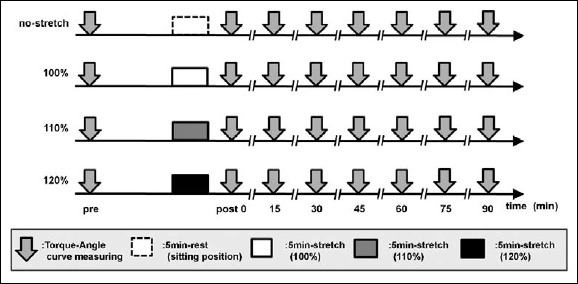
Study design and outcome measurement timing.
Stretching protocol
The sitting position with the hip joint flexed (Figure 2A) was used as the resting position from which the hamstring muscles could be efficiently stretched (Matsuo et al., 2013) and the sustained effect subsequently measured. During the experiment, the participants were seated on a chair with an isokinetic dynamometer (Primus RS; BTE Technologies, Hanover, MD, USA). The seat was maximally tilted to 35° from horizontal, and a cushion was inserted between the backrest and the participant’s back to achieve a 60° angle between the seat and the participant’s back. The right thigh, pelvis, and chest were stabilized to the chair with hook and loop fasteners. The knee joint was aligned with the isokinetic dynamometer axis of rotation with attachment of the moment arm at the medial malleolus and stabilized with hook and loop fastener straps. This resulted in hip and knee flexion angles of 111.3° ± 1.6° and 110.0° ± 2.1°, respectively. The right hamstring muscles were stretched by the isokinetic dynamometer, and the participants were instructed to maintain relaxed muscles. Five minutes of static stretching was performed by holding the knee angle at 100%, 110%, or 120% of the pre-tested knee extension ROM (described below) to stretch at the three different intensities (Figure 2B). Matsuo et al. (2013) indicated that ROM and stiffness changed significantly with 5 minutes of stretching at 100% intensity. Thus, 5 minutes of stretching at 100% intensity was expected to increase ROM and decrease stiffness in the present study. The sustained effect was then measured from the resting position.
Figure 2.

Image of stretch by range of motion percentage. The sitting position used during static knee flexor stretching before (A) and during stretch at 100%, 110%, and 120% intensity (B).
SPT
Passive torque of the hamstrings during stretch was continuously measured by the isokinetic dynamometer. Isokinetic dynamometer torque and angle signals during stretch were digitized (Powerlab 4/20T; ADInstruments, NSW, Australia) and recorded (Dynabook Satellite J50; Toshiba, Tokyo, Japan). A previous study reported that SPT decreased during static stretch (Matsuo et al., 2013); thus, the changes in SPT every minute from the onset of stretch were calculated (LabChart 4; ADInstruments).
Pain intensity during stretch
To quantify pain during hamstring stretching, the NRS (Hakkinen et al., 2007) was used every minute from the onset of stretch. The NRS ranged from 0 to 10, where 0 indicated no pain and 10 indicated very, very painful.
EMG
Stretching of the medial and lateral hamstrings was recorded using EMG (Biomonitor ME6000; Mega Electronics, Kuopio, Finland) with a 1-kHz sampling frequency. The EMG signal was not filtered. The common mode rejection ratio was >100, the input impedance was <50 kOhms, and the extent of noise ranged from 5 to 15 μV. At the locations of electrode placement, the skin was shaved, scrubbed, and cleaned with alcohol. Two silver/silver chloride sensors (Blue Sensor M-00-s; Ambu, Ballerup, Denmark) with an inter-electrode distance of 35 mm were placed at the midpoint between the ischial tuberosity and the tibial medial epicondyle for the medial hamstring and at the midpoint between the ischial tuberosity and the tibial lateral epicondyle for the lateral hamstring. The raw EMG signals were recorded digitally, and the iEMG values were calculated (MegaWin; Mega Electronics, Kuopio, Finland) every minute from the onset of stretch.
ROM, DPTmax, and stiffness
ROM, DPTmax, and stiffness were determined from the torque-angle curve obtained from the isokinetic dynamometer, and the torque and angle signals were converted and stored digitally. Seated participants (Figure 2A) were required to passively extend the knee at 5°/second to the point of pain onset, at which point torque was recorded to obtain the torque-angle curve (Matsuo et al., 2013). A 5°/second stretch was chosen because this velocity avoids reflexive muscle contraction (Gajdosik, 2006). During the measurement, the participants were asked not to exert any resistance and to remain relaxed. The ROM was defined as the maximum angle of the knee from the starting position (0°), and DPTmax, which was used as a measure of tolerance to stretch, was defined as the torque measurement at pain onset (Halbertsma et al., 1996; Mizuno et al., 2013). As shown in Figure 3, stiffness was defined using the least-square method involving the slope of the regression from the torque-angle curve (Matsuo et al., 2013). Stiffness was calculated from the torque at half of the maximum knee extension angle for each individual participant, and the minimum ROM was recorded (Figure 3). This knee joint angle was used at all time points for each individual participant.
Figure 3.
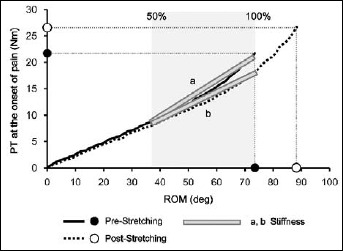
Representative torque-angle curve values. Typical torque-angle curve response of one subject before and after passive static stretch. Stiffness was determined from the slope of the regression between 50% and 100% of the range of motion (ROM)–passive torque (PT) relationship.
Test-retest reliability
To ensure day-to-day reproducibility in the measurements, the test-retest reliability of ROM, stiffness, and DPTmax was determined from a pilot study of 6 participants (3 men and 3 women). The two tests were performed 1-7 days apart at the same time of the day (± 1 hour). On the basis of the intra-class correlation coefficient (ICC1,1), the reliability was high for all measures (ROM: 0.98, stiffness: 0.93, DPTmax: 0.94). The coefficient of variation (CV) was also determined (ROM: 0.1%, stiffness: 4.7%, DPTmax: 4.1%), and all measures showed acceptable reliability.
Statistical analyses
Data are presented as mean ± standard deviation. The Shapiro–Wilk test was used to assess the normality of the data. Among the data, ROM, DPTmax, and SPT were normally distributed. For non-normally distributed data, parametric tests were used, while non-parametric tests were used for other variables, including for relative changes. Two-way repeated-measures analysis of variance (ANOVA) was used to compare SPT, and the Friedman test was used to compare the NRS and iEMG results between the three stretch intensity protocols (100%, 110%, and 120%) over time (0, 1, 2, 3, 4, and 5 minutes of stretch). Two-way repeated measures ANOVA was also performed to compare the ROM and DPTmax, and the Friedman test was used to compare stiffness and the relative changes in all variables between the stretch intensity protocols (no stretch, 100%, 110%, and 120%) over time (before and 0, 15, 30, 45, 60, 75, and 90 minutes after) and the effect size (r) was calculated. The Bonferroni post-hoc test was used to identify significant differences between each time point and compared with baseline. Spearman’s rank-order coefficients were determined for the intensity of stretch and the changes in ROM, stiffness, DPTmax, and SPT, and Pearson’s correlation coefficients were calculated for changes in ROM, stiffness, DPTmax, and SPT. All statistical analyses were performed using SPSS software (version 16.0J; SPSS Inc., Chicago, IL, USA). An α level of 0.05 was defined as statistically significant.
Results
SPT
A significant interaction effect was identified (time × condition) for SPT (p = 0.001). The post-hoc analysis identified a significant decrease in SPT at minutes 1–5 compared with minute 0 at stretch intensities of 100%, 110%, and 120% (p < 0.001) (Figure 4A). At minute 0, SPT at 120% intensity was significantly greater than at 100% and 110% intensity (p < 0.001), and SPT at 110% intensity was significantly greater than SPT at 100% intensity (p < 0.001). At minute 1, SPT decreased significantly after stretch at 120% intensity compared with SPT after stretch at 100% intensity. Moreover, at minutes 2–5, SPT decreased significantly after stretch at 120% intensity compared with SPT after stretch at 100% and 110% intensity (p < 0.001), and SPT decreased significantly after stretch at 110% intensity compared with SPT after stretch at 100% intensity (p < 0.001) (Figure 4B).
Figure 4.
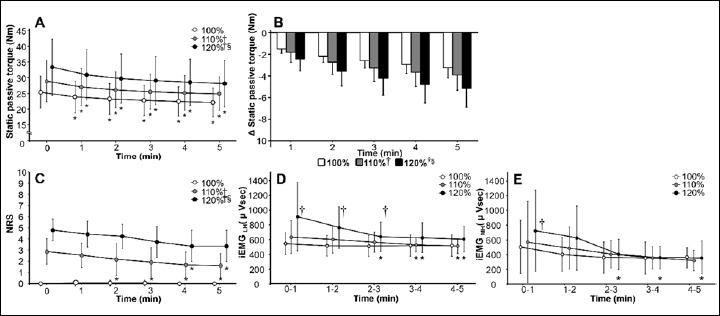
The parameters recorded during stretch. Changes in static passive torque (A), the reduction in static passive torque from the onset of stretch (B), pain intensity assessed using the numeric rating scale (NRS) (C), integrated electromyography of the lateral hamstring (iEMGLH) (D), and integrated electromyography of the medial hamstring (iEMGMH) (E) from the onset to the end of 5-minute passive static stretch at 100%, 110%, and 120% intensity. *: Significantly (p < 0.05) different from beginning; †: significantly (p < 0.05) different from stretch at 100% intensity; §: significantly (p < 0.05) different from stretch at 110% intensity. Data are presented as mean ± standard deviation.
Pain intensity during stretch
The NRS value significantly decreased at minutes 2-5 when compared with the NRS value at minute 0 in response to a stretch intensity of 110%. It decreased significantly at minutes 4 and 5 when compared with minute 0 in response to stretch at an intensity of 120% (p < 0.05) (Figure 4C). The NRS value in response to stretch at 120% intensity was significantly greater than at 100% and 110% intensity. Moreover, the NRS value at an intensity of 110% was greater than the NRS value at 100% intensity at minutes 0–5 (p < 0.001).
EMG
The iEMGLH values decreased significantly at minutes 3–4 and 4–5 when compared with minutes 0-1 at 110% intensity and also at minutes 2-3, 3-4, and 4-5 when compared with minutes 0-1 at 120% intensity (p < 0.05) (Figure 4D). iEMGLH at 120% intensity was significantly greater than at 100% intensity at minutes 0-1, 1-2, and 2-3 (p < 0.05); however, there was no significant difference between these protocols after minutes 3-4. The iEMGMH values decreased significantly after stretch at minutes 2-3, 3-4, and 4-5 when compared with minutes 0-1 at an intensity of 120% (p < 0.05) (Figure 4E), and iEMGMH at an intensity of 120% was significantly greater than at an intensity of 100% at minutes 0-1 (p < 0.05), but no significant difference was noted between the three protocols after minutes 1-2.
ROM, DPTmax, and stiffness
There were no differences among the pre- and post-stretch absolute ROM, stiffness, and DPTmax values when assessing the time course effects. To assess changes in magnitude across the three stretching intensities, the values were normalized to the pre-stretch results and compared across the three intensities.
A significant interaction effect was found for ROM (p = 0.001, effect size r = 0.911, F value = 73.639, degrees of freedom = 15). ROM significantly increased immediately after stretch at 100%, 110%, and 120% intensity (p = 0.001), but it was unchanged after no stretch (Table 1). The ROM increment lasted until 30 minutes after stretch at 100% intensity (p < 0.05) and 75 minutes after stretch at 110% intensity (p < 0.05), and returned to the pretreatment values for the remaining periods, but it lasted for >90 minutes after stretch at 120% intensity (p < 0.05). The magnitude of the increase in ROM immediately after stretch was significantly greater with stretch at an intensity of 120% (14%) than for stretch at an intensity of 110% (10%) or 100% (6%) (p < 0.05) (Figure 5A).
Table 1.
Repeated measures quantified outcomes. Changes in range of motion (ROM), passive stiffness, and maximum dynamic passive torque (DPTmax) immediately before (pre), immediately after (0), and 15, 30, 45, 60, 75, and 90 minutes after no stretch or static stretch at 100%, 110%, and 120% intensity.
| Outcome measure | Condition | Time | |||||||
|---|---|---|---|---|---|---|---|---|---|
| Pre | 0 min | 15 min | 30 min | 45 min | 60 min | 75 min | 90 min | ||
|
ROM
(°) |
no-stretch | 83.1 (7.8) | 83.7 (8.2) | 83.6 (8.0) | 83.5 (7.3) | 83.9 (7.3) | 84.0 (7.1) | 84.2 (7.0) | 83.9 (6.9) |
| 100% | 84.0 (7.8) | 89.0 (8.5) * ¶ | 88.1 (7.9) * ¶ | 86.8 (7.9)*¶ | 86.0 (8.0) | 86.0 (8.6) | 85.0 (7.9) | 84.5 (7.2) | |
| 110% | 83.8 (8.8) | 91.6 (8.5) * ¶ | 90.3 (8.2)*¶† | 89.3 (8.5)*¶† | 88.5 (8.5)*¶† | 87.8 (8.5) * | 86.7 (9.3)* | 85.8 (8.7) | |
| 120% | 83.4 (8.6) | 94.9 (9.4) * ¶ † | 91.9 (9.3)*¶† | 91.8 (9.1)*¶† | 90.3 (8.7)*¶† | 89.8 (8.9)*¶† | 88.5 (9.2)*¶† | 87.6 (8.8)*¶† | |
|
Stiffness
(N·m/°) |
no-stretch | 0.384 (0.08) | 0.383 (0.08) | 0.377 (0.09) | 0.371 (0.08) | 0.364 (0.08) | 0.366 (0.08) | 0.367 (0.09) | 0.365 (0.09) |
| 100% | 0.396 (0.09) | 0.365 (0.08) * | 0.378 (0.09) * | 0.374 (0.08)* | 0.377 (0.08) | 0.377 (0.08) | 0.381 (0.08) | 0.382 (0.09) | |
| 110% | 0.387 (0.08) | 0.353 (0.07) * | 0.358 (0.08) * | 0.357 (0.08)* | 0.363 (0.08)* | 0.371 (0.09) | 0.373 (0.08) | 0.369 (0.08) | |
| 120% | 0.399 (0.10) | 0.333 (0.09)*¶† | 0.356 (0.09) * | 0.355 (0.10)* | 0.365 (0.10)* | 0.372 (0.09)* | 0.374 (0.10)* | 0.375 (0.10)* | |
|
DPTmax
(N·m) |
no-stretch | 27.8 (6.4) | 28.2 (6.6) | 27.8 (6.4) | 27.3 (6.1) | 27.3 (6.3) | 27.0 (6.1) | 27.4 (6.5) | 27.3 (6.6) |
| 100% | 28.2 (6.7) | 30.6 (6.6) * | 29.9 (6.5) * | 29.1 (5.8) | 28.7 (6.2) | 28.5 (6.0) | 28.3 (5.9) | 28.1 (6.6) | |
| 110% | 27.6 (5.8) | 31.6 (6.0) * ¶ | 30.1 (6.6) * | 29.7 (6.2)*¶ | 29.2 (6.2) ¶ | 29.3 (6.5) ¶ | 28.8 (6.1) | 27.9 (5.7) | |
| 120% | 28.3 (7.1) | 32.5 (8.1) * ¶ | 31.4 (8.0) * ¶ | 31.0 (8.3)*¶ | 30.8 (8.3)*¶ | 30.8 (7.8)*¶ | 29.4 (7.6)*¶ | 29.5 (7.0)¶ | |
*: significantly (p < 0.05) different from pre-stretch;
¶: significantly (p < 0.05) different from no stretch;
†: significantly (p < 0.05) different from stretch at 100% intensity (relative value);
§: significantly (p < 0.05) different from stretch at 110% intensity (relative value). Data are presented as mean ± standard deviation.
Figure 5.
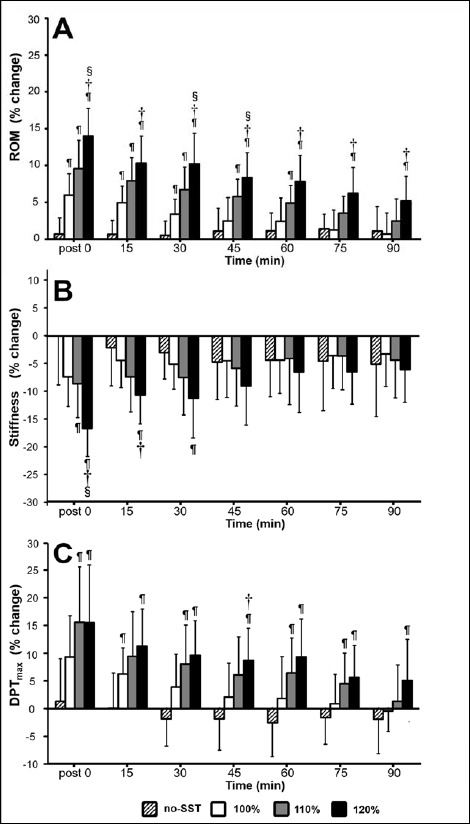
Normalized repeated-measures outcomes. Normalized changes in range of motion (ROM) (A), passive stiffness (B), and (C) maximum dynamic passive torque (DPTmax) from the pre-stretch values (100%), immediately before (pre), immediately after (0), and 15, 30, 45, 60, 75, and 90 minutes after static stretch at 100%, 110%, or 120% intensity, or without stretch (control). †: significantly (p < 0.05) different from stretch at 100% intensity (relative value); §: significantly (p < 0.05) different from stretch at 110% intensity (relative value). Data are presented as mean ± standard deviation.
Stiffness was significantly decreased immediately after stretching at 100%, 110%, and 120% intensity (p = 0.001, effect size r = 0.529, F value = 5.830, degrees of freedom = 15), but it was unchanged in the control condition (no stretch) (Table 1). A decrease in stiffness lasted until 30 minutes after stretch at 100% intensity (p < 0.05) and 45 minutes after stretch at 110% intensity (p < 0.05) and then returned to the pretreatment values for the remaining periods, but it lasted >90 minutes after stretch at 120% intensity (p < 0.05). The magnitude of the decrease in stiffness immediately after stretching was significantly greater for stretch at 120% intensity (17%) than for stretch at 110% (9%) and 100% (7%) intensity (p < 0.05) (Figure 5B).
A significant interaction effect was found for DPTmax (p = 0.001, effect size r = 0.395, F value = 2.766, degrees of freedom = 15). DPTmax significantly increased immediately after stretch at 100%, 110%, and 120% intensity (p = 0.001), but it was unchanged in the control condition (Table 1). Moreover, the increment in DPTmax lasted until 15 minutes after stretch at 100% intensity (p < 0.05), 30 minutes after stretch at 110% intensity (p < 0.05), and 75 minutes after stretch at 120% intensity (p < 0.05). The magnitude of the increase in DPTmax immediately after stretch was significantly greater for stretch at 120% (15%) and 110% (15%) intensity than stretch at 100% (9%) intensity (p < 0.05) (Figure 5C).
Correlation between outcomes
Stretch intensity and the SPT at the onset of stretch strongly correlated (ρ = 0.91, p < 0.001). Moreover, changes in flexibility immediately after stretch exhibited moderate correlations, including ROM (%) (ρ = 0.63, p < 0.001) and stiffness (%) (ρ = -0.58, p < 0.001) (Figures 6A and 6B). Additional moderate-to-strong correlations were identified across ROM (%) and changes in stiffness (%) (r = -0.55, p < 0.001) and DPTmax (%) (r = 0.77, p < 0.001) (Figures 6C and 6D). The change in stiffness was correlated with the SPT value at the onset of stretch (Nm) (r = 0.31, p < 0.05) and the reduction in SPT (Nm) (r = 0.33, p < 0.01).
Figure 6.
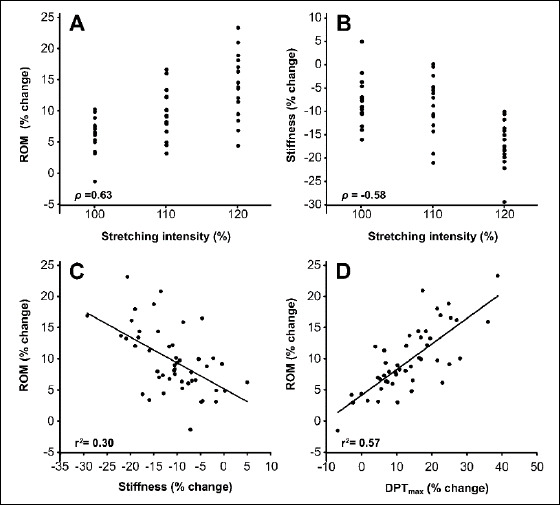
Spearman’s and Pearson’s correlation coefficients. The relationships between the changes in indicators of flexibility and stretch intensity. A moderate correlation was observed between stretch intensity and changes in A) range of motion (ROM) (ρ = 0.63) and B) passive stiffness (ρ = –0.58). Moderate-to-strong correlations were observed between changes in ROM and changes in C) passive stiffness (r = –0.55) and D) maximum dynamic passive torque (DPTmax) (r = 0.77).
Discussion
The results of this study support the hypothesis that high-intensity stretch improves hamstring ROM and stiffness to a greater extent and for a longer duration than maximal intensity stretch without pain. In terms of the intensity of stretch, it is generally recommended that static stretch should be performed without causing pain because high-intensity stretch with pain can have negative effects, such as involuntary muscle contraction and stretch reflex (Anderson and Anderson, 2010). However, a systematic review showed that there is little published evidence to support this conclusion (Apostolopoulos et al., 2015b). One previous study compared stretch with and without pain (Apostolopoulos et al., 2015a), and showed that high-intensity stretch of the hamstrings (90% ROM) was associated with a higher C-reactive protein concentration in the blood, which is a biomarker of inflammation, than lower intensity stretch (30% or 60% ROM). Moreover, Jacobs and Sciascia (2011) showed that stretching beyond the pain threshold for prolonged periods is associated with an inflammatory response. However, little is known about the influence of stretch with pain.
The main findings of the present study were as follows: 1) the magnitude of the increase in ROM and DPTmax and the decrease in stiffness after stretch differed significantly depending on the intensity of stretch; 2) the effects of stretch on ROM, stiffness, and DPTmax lasted longer with high-intensity stretch; 3) along with the intensity of stretch, the greater SPT was loaded and pain and involuntary muscle activity were observed during stretch; however, the degree of pain and involuntary muscle activity were gradually attenuated during stretch; 4) the increase in the ROM was associated with both a decrease in stiffness and an increase in stretch tolerance. These findings support the hypotheses that high-intensity stretch has a stronger effect on ROM through mechanical and sensory mechanisms than maximal intensity stretch without pain.
The baseline values of ROM, stiffness, DPTmax, and SPT at 100% intensity closely resembled the results of previous studies on healthy participants (Cabido et al., 2013; Marshall et al., 2011; Matsuo et al., 2013). The baseline values were the same across conditions, while the ICC and CV indicated good measurement test-retest reliability. Furthermore, as indicated in Figures 4 and 5, SPT and stiffness decreased with the 5-minute static hamstring stretch at 100% intensity, while ROM and DPTmax increased immediately after stretch. Importantly, these changes recapitulate the results of previous studies showing changes with 5 minutes of static hamstring stretching (SPT = 13%, ROM = 6%, stiffness = 7%, and DPTmax = 9%) (Cabido et al., 2013; Matsuo et al., 2013). Therefore, the present study design was deemed appropriate to compare the responses to different stretch intensities.
Although there are extensive reports on flexibility after static stretch, we are not aware of any reports that have directly compared multiple stretch intensities. These findings regarding increased and longer-lasting improvements in flexibility after high-intensity stretch have new and potentially impactful implications. Specifically, high-intensity stretch improves flexibility, even though it causes mild-to-moderate pain, particularly at the onset of stretch. Previous studies have reported that less muscle flexibility could increase the risk of muscle injury during sport (Watsford et al., 2010; Witvrouw et al., 2003). Thus, the findings of the present study support that high-intensity stretch could reduce the risk of muscle injury (Cross and Worrell, 1999).
The most striking influence of stretch intensity was observed in ROM (Figure 5A and Table 1). Our results show that high-intensity stretch caused a stronger (100% intensity: 6%, 110% intensity: 10%, and 120% intensity: 16%) and longer-lasting (100% intensity: 30 minutes, 110% intensity: 75 minutes, and 120% intensity: 90 minutes) increase in ROM than maximal intensity stretch without pain. In addition, as shown in Figure 6A, the intensity of stretch correlated with the change in ROM (%) immediately after stretch (ρ = 0.63, p < 0.001). These results suggest that high-intensity stretch elicits a stronger effect on ROM. Numerous studies have shown significant increases in ROM after static stretch without pain (Matsuo et al., 2013; Mizuno et al., 2013; Ryan et al. 2008b; Weppler and Magnusson, 2010). Although the actual mechanisms responsible for the acute increase in ROM after static stretch are not yet fully understood, a decrease in stiffness and an increase in DPTmax have been proposed as potential mechanisms (Magnusson et al., 1996a; Mizuno et al., 2013; Weppler and Magnusson, 2010). The present study revealed significant correlations between stretch intensity and relative changes in ROM (%) and stiffness (%) (Figures 6A and 6B). These results are in agreement with previous reports from Kataura et al. (2017) and Takeuchi et al. (2021a), who investigated the effects of high-intensity stretch of the hamstrings. Moreover, the present study indicated that the change in ROM (%) immediately after stretch correlated with changes in stiffness and DPTmax (Figures 6C and 6D), and changes in stiffness and DPTmax were stronger and longer lasting after stretch at 110% or 120% intensity than after stretch at 100% intensity. Therefore, the greater and longer-lasting change in ROM after high-intensity stretch might be attributable to changes in stiffness and DPTmax in the present study. This may explain the greater and longer-lasting increase in ROM after stretch at 110% and 120% intensity than after stretch at 100% intensity.
A greater decrease in stiffness was observed immediately after stretch at 120% intensity (17%) than after stretch at 110% (9%) or 100% (7%) intensity (Table 1, Figure 5B), and stiffness remained lower than at baseline for 30, 45, and 90 minutes after stretch at 100%, 110%, and 120% intensity, respectively. Moreover, as shown in Figure 6B, the stretch intensity correlated with changes in stiffness (%) immediately after stretch (ρ = -0.58, p < 0.001). These results suggest that the stretch-induced decrease in stiffness may be governed by a dose–response relationship. Some studies have suggested that the magnitude and time course of the decrease in stiffness may be dose-dependent. For example, Ryan et al. (2008a) showed that the decrease in stiffness returned to normal within 10 minutes after a 2 - minute stretch, while it lasted for 10 minutes after 4 - and 8 - minute stretches. Matsuo et al. (2013) reported that the magnitude of the decrease in stiffness was dependent on the duration of stretch such that the longer the duration (e.g. ≥180 seconds), the greater the effect. Moreover, stretching for relatively short durations (Magnusson et al., 1996c; Magnusson et al., 1998; Magnusson et al., 2000) (1.5-2.25 minutes) did not change stiffness. In contrast, longer stretching durations (Magnusson et al., 1996b; Nordez et al., 2006) (2.5 and 7.5 minutes) reduced hamstring stiffness. As is the case with the duration of stretch, the intensity of stretch may influence the magnitude and retention time of the decrease in stiffness.
Previous studies (Cabido et al., 2013; Herda et al., 2011) have reported that constant torque stretching causes a greater decrease in stiffness than constant-angle stretch and explain that constant torque stretch places more tension and/or applies more work on the muscle-tendon unit than constant-angle stretch. In the present study, SPT was significantly greater for stretch at 120% intensity than stretch at 100% or 110% intensity, and the decrease in SPT (stress relaxation) was greater for stretch at 120% intensity than at 100% or 110% intensity (Figures 4A and 4B). Furthermore, there was a fair positive correlation between the change in SPT and stiffness. Hirata et al. (2020) showed a correlation between the muscle shear modulus at the maximal angle of dorsiflexion prior to stretch and the stretch-induced decrease in muscle shear modulus. This supports the hypothesis that high-intensity stretch can reduce muscle stiffness. Previous studies (Magnusson et al., 1995; McHugh et al., 1992) have suggested that stress relaxation is mainly caused by mechanical factors, such as viscoelasticity. Therefore, high-intensity stretch may cause a greater reduction in stiffness, accompanied by a greater change in the mechanical properties of the muscle-tendon unit during stretch.
As shown in Table 1 and Figure 5C, high-intensity stretch caused a greater and longer-lasting increase in DPTmax than maximal intensity stretch without pain. It is considered that DPTmax, which is defined as the passive torque at the onset of pain, is determined by the pain threshold or stretch tolerance (Halbertsma et al., 1996; Magnusson et al., 1996c). In the present study, moderate pain (NRS) (100% intensity: 0, 110% intensity: 2.9, 120% intensity: 4.8) and EMG activity (% maximal voluntary isometric contractions (MVC) of the lateral hamstrings) (100% intensity: 3.1%, 110% intensity: 3.8%, 120% intensity: 5.2%) were monitored immediately after the onset of high-intensity stretch, although these responses attenuated by gradation (NRS) (100% intensity: 0, 110% intensity: 1.6, 120% intensity: 3.4) (%MVC of the lateral hamstring) (100% intensity: 3.0%, 110% intensity: 3.1%, 120% intensity: 3.4%). Hence, modification of pain sensation during high-intensity stretch might contribute to a greater increase in stretch tolerance. Although little is known about the mechanisms underpinning the change in stretch tolerance, previous studies (Blazevich et al., 2012; Laessoe and Voigt, 2004; Weppler and Magnusson, 2010) have suggested that neuromuscular factors influence the maximum stretch limit. Blazevich et al. (2012) reported that the angle of EMG activity onset was correlated with the maximal ROM of the human plantar flexor. Thus, it seems that the change in stretch tolerance might have been related to the change in involuntary muscle activity during stretch in the present study.
As for the retention time of the stretch-induced effects, a previous study (Mizuno et al., 2013) reported that the change in stiffness returned to normal more rapidly than the changes in ROM and DPTmax after stretching of the plantar flexors. Contrary to this previous study, the decrease in stiffness lasted longer (100% intensity: 30 minutes, 110% intensity: 45 minutes, 120% intensity: 90 minutes) than the increase in DPTmax (100% intensity: 15 minutes, 110% intensity: 30 minutes, 120% intensity: 75 minutes) after stretch in the present study. One of the possible reasons for this contradiction is the difference in the target muscle. McHugh and Cosgrave (2010) showed that the change in stiffness after hamstring stretch was stronger and longer lasting than that of the plantar flexors. Therefore, the decrease in hamstring stiffness might last longer than the decrease in plantar flexor stiffness.
The present study has some limitations that should be noted. First, all of the participants were healthy young people. Therefore, the results might have differed if the participants were older or suffered from conditions, such as pain, tightness, or muscle damage. More effective methods are required to improve flexibility in athletes; thus, the present study may be especially useful in the field of sport. Second, the method used to determine the intensity of stretch is also a limitation. In the present study, the intensity was defined by the stretch angle (Young et al., 2006) to set the dose of stretch quantitatively. Recently, previous studies have suggested the application of constant torque stretch (Cabido et al., 2013; Herda et al., 2011; Herda et al., 2014; Ryan et al., 2012), while other studies have reviewed other forms of high-intensity stretch (Frietas and Mil-Homens 2015; Frietas et al., 2016; Fukaya et al., 2020). The effects of stretch were influenced by the amount of SPT in the present study; thus, determining the intensity using torque would be interesting to investigate the effects of variable mechanical loading during stretch. In addition, the degree of pain could also be used easily and practically as an index of stretch intensity. Third, the safety of high-intensity stretch should be considered. Although no participants complained of pain or discomfort after high-intensity stretch in the present study, microscopic muscle damage might have occurred if the stretch intensity was too high. Therefore, careful consideration would be required in practice. Future studies should consider investigating the chronic effects of stretch intensity in daily training or treatment.
Conclusion
The results of this study support our hypothesis that high-intensity stretch produces greater and longer-lasting effects on flexibility than lower intensity stretch, suggesting that the effects of stretch on flexibility are governed by a dose–response relationship. The data from this study show that the increase in ROM is attributable to the changes in stiffness and stretch tolerance.
Acknowledgements
This work did not receive funding. We thank Emily Woodhouse, PhD, from Edanz (https://jp.edanz.com/ac) for editing a draft of this manuscript. The authors have no conflicts of interest to declare. The experiments comply with the current laws of the country in which they were performed. The datasets generated during and/or analyzed during the current study are not publicly available, but are available from the corresponding author who was an organizer of the study.
Biographies

Genki HATANO
Employment
Institute of Sport Science, ASICS Corporation, Kobe, Japan
Degree
M.S. in Physical Therapy
Research interests
Sports engineering, exercise physiology and biomechanics
E-mail: genki.hatano@asics.com

Shingo MATSUO
Employment
Department of Rehabilitation, Faculty of Health Sciences, Nihon Fukushi University, Handa, Japan
Degree
Ph.D. in Rehabilitation Science
Research interests
Stretching exercise and muscle flexibility
E-mail: matsuo@n-fukushi.ac.jp

Yuji ASAI
Employment
Department of Rehabilitation, Faculty of Health Sciences, Nihon Fukushi University, Handa, Japan
Degree
Ph.D. in Medicine
Research interests
Postural control and vestibular rehabilitation
E-mail: asai@n-fukushi.ac.jp

Shigeyuki SUZUKI
Employment
Department of Health and Sports Sciences, School of Health Sciences, Asahi University, Mizuho, Japan
Degree
Ph.D. in Medicine
Research interests
Evidence based stretching for exercise and rehabilitation
E-mail: suzuki@met.nagoya-u.ac.jp

Masahiro IWATA
Employment
Department of Rehabilitation, Faculty of Health Sciences, Nihon Fukushi University, Handa, Japan
Degree
Ph.D. in Physical Therapy
Research interests
Exercise physiology, skeletal muscle biology, and mechanobiology
E-mail: iwata-m@n-fukushi.ac.jp
References
- Anderson B., Anderson J. (2010) Stretching. 30th anniversary edition. California: Shelter Publications. [Google Scholar]
- Apostolopoulos N., Metsios G. S., Nevill A., Koutedakis Y., Wyon M. A. (2015a) Stretch intensity vs. inflammation: a dose-dependent association? International Journal of Kinesiology and Sports Science 3, 27-31. https://doi.org/10.7575/aiac.ijkss.v.3n.1p.27 10.7575/aiac.ijkss.v.3n.1p.27 [DOI] [Google Scholar]
- Apostolopoulos N., Metsios G. S., Flouris A. D., Koutedakis Y., Wyon M. A. (2015b) The relevance of stretch intensity and position-a systematic review. Frontiers in Psychology 6, 1128. https://doi.org/10.3389/fpsyg.2015.01128 10.3389/fpsyg.2015.01128 [DOI] [PMC free article] [PubMed] [Google Scholar]
- Behm D. G., Chaouachi A. (2011) A review of the acute effects of static and dynamic stretching on performance. European Journal of Applied Physiology 111, 2633-2651. https://doi.org/10.1007/s00421-011-1879-2 10.1007/s00421-011-1879-2 [DOI] [PubMed] [Google Scholar]
- Blazevich A. J., Cannavan D., Waugh C. M., Fath F., Miller S. C., Kay A. D. (2012) Neuromuscular factors influencing the maximum stretch limit of the human plantar flexors. Journal of Applied Physiology 113, 1446-1455. https://doi.org/10.1152/japplphysiol.00882.2012 10.1152/japplphysiol.00882.2012 [DOI] [PubMed] [Google Scholar]
- Cabido C. E., Bergamini J. C., Andrade A. G., Lima F. V., Menzel H. J., Chagas M. H. (2013) Acute effect of constant torque and angle stretching on range of motion, muscle passive properties, and stretch discomfort perception. The Journal of Strength & Conditioning Research 28, 1050-1057. https://doi.org/10.1519/JSC.0000000000000241 10.1519/JSC.0000000000000241 [DOI] [PubMed] [Google Scholar]
- Cross K. M., Worrell T. W. (1999) Effects of a static stretching program on the incidence of lower extremity musculotendinous strains. Journal of Athletic Training 34, 11-14. [PMC free article] [PubMed] [Google Scholar]
- Fowles J. R., Sale D. G., MacDougall J. D. (2000) Reduced strength after passive stretch of the human plantarflexors. Journal of Applied Physiology 89, 1179-1188. https://doi.org/10.1152/jappl.2000.89.3.1179 10.1152/jappl.2000.89.3.1179 [DOI] [PubMed] [Google Scholar]
- Freitas S. R., Mil-Homens P. (2015) Effect of 8-week high-intensity stretching training on biceps femoris architecture. Journal of Strength and Conditioning Research 29, 1737-1740. https://doi.org/10.1519/JSC.0000000000000800 10.1519/JSC.0000000000000800 [DOI] [PubMed] [Google Scholar]
- Freitas S. R., Andrade R. J., Nordez A., Mendes B., Mil-Homens P. (2016) Acute muscle and joint mechanical responses following a high-intensity stretching protocol. European Journal of Applied Physiology 116, 1519-1526. https://doi.org/10.1007/s00421-016-3410-2 10.1007/s00421-016-3410-2 [DOI] [PubMed] [Google Scholar]
- Fukaya T., Kiyono R., Sato S., Yahata K., Yasaka K., Onuma R., Nakamura M. (2020) Effects of static stretching with high-intensity and short-duration or low-intensity and long-duration on range of motion and muscle stiffness. Frontiers in Physiology 11, 1535. https://doi.org/10.3389/fphys.2020.601912 10.3389/fphys.2020.601912 [DOI] [PMC free article] [PubMed] [Google Scholar]
- Gajdosik R. L. (2001) Passive extensibility of skeletal muscle: review of the literature with clinical implications. Clinical Biomechanics 16, 87-101. https://doi.org/10.1016/S0268-0033(00)00061-9 10.1016/S0268-0033(00)00061-9 [DOI] [PubMed] [Google Scholar]
- Gajdosik R. L. (2006) Influence of a low-level contractile response from the soleus, gastrocnemius and tibialis anterior muscles on viscoelastic stress-relaxation of aged human calf muscle-tendon units. European Journal of Applied Physiology 96, 379-388. https://doi.org/10.1007/s00421-005-0091-7 10.1007/s00421-005-0091-7 [DOI] [PubMed] [Google Scholar]
- Hakkinen A., Salo P., Tarvainen U., Wiren K., Ylinen J. (2007) Effect of manual therapy and stretching on neck muscle strength and mobility in chronic neck pain. Journal of Rehabilitation Medicine 39, 575-579. https://doi.org/10.2340/16501977-0094 10.2340/16501977-0094 [DOI] [PubMed] [Google Scholar]
- Halbertsma J. P., van Bolhuis A. I., Goeken L. N. (1996) Sport stretching: effect on passive muscle stiffness of short hamstrings. Archives of Physical Medicine and Rehabilitation 77, 688-692. https://doi.org/10.1016/S0003-9993(96)90009-X 10.1016/S0003-9993(96)90009-X [DOI] [PubMed] [Google Scholar]
- Hatano G., Suzuki S., Matsuo S., Kataura S., Yokoi K., Fukaya T., Fujiwara M., Asai Y., Iwata M. (2019) Hamstring stiffness returns more rapidly after static stretching than range of motion, stretch tolerance, and isometric peak torque. Journal of Sport Rehabilitation 28, 325-331. https://doi.org/10.1123/jsr.2017-0203 10.1123/jsr.2017-0203 [DOI] [PubMed] [Google Scholar]
- Herda T. J., Costa P. B., Walter A. A., Ryan E. D., Cramer J. T. (2014) The time course of the effects of constant-angle and constant-torque stretching on the muscle-tendon unit. Scandinavian Journal of Medicine & Science in Sports 24, 62-67. https://doi.org/10.1111/j.1600-0838.2012.01492.x 10.1111/j.1600-0838.2012.01492.x [DOI] [PubMed] [Google Scholar]
- Herda T. J., Costa P. B., Walter A. A., Ryan E. D., Hoge K. M., Kerksick C. M., Stout J. R., Cramer J. T. (2011) Effects of two modes of static stretching on muscle strength and stiffness. Medicine and Science in Sports and Exercise 43, 1777-1784. https://doi.org/10.1249/MSS.0b013e318215cda9 10.1249/MSS.0b013e318215cda9 [DOI] [PubMed] [Google Scholar]
- Hirata K., Yamadera R., Akagi R. (2020) Can static stretching reduce stiffness of the triceps surae in older men? Medicine and Science in Sports and Exercise 52, 673-679. https://doi.org/10.1249/MSS.0000000000002186 10.1249/MSS.0000000000002186 [DOI] [PMC free article] [PubMed] [Google Scholar]
- Jacobs C. A., Sciascia A. D. (2011) Factors that influence the efficacy of stretching programs for patients with hypomobility. Sports Health 3, 520-523. https://doi.org/10.1177/1941738111415233 10.1177/1941738111415233 [DOI] [PMC free article] [PubMed] [Google Scholar]
- Kataura S., Suzuki S., Matsuo S., Hatano G., Iwata M., Yokoi K., Tsuchida W., Banno Y., Asai Y. (2017) Acute effects of the different intensity of static stretching on flexibility and isometric muscle force. The Journal of Strength & Conditioning Research 31, 3403-3410. https://doi.org/10.1519/JSC.0000000000001752 10.1519/JSC.0000000000001752 [DOI] [PubMed] [Google Scholar]
- Kubo K., Kanehisa H., Kawakami Y., Fukunaga T. (2001) Influence of static stretching on viscoelastic properties of human tendon structures in vivo. Journal of Applied Physiology 90, 520-527. https://doi.org/10.1152/jappl.2001.90.2.520 10.1152/jappl.2001.90.2.520 [DOI] [PubMed] [Google Scholar]
- Laessoe U., Voigt M. (2004) Modification of stretch tolerance in a stooping position. Scandinavian Journal of Medicine & Science in Sports 14, 239-244. https://doi.org/10.1111/j.1600-0838.2003.00332.x 10.1111/j.1600-0838.2003.00332.x [DOI] [PubMed] [Google Scholar]
- Magnusson S. P., Aagaard P., Nielson J. J. (2000) Passive energy return after repeated stretches of the hamstring muscle-tendon unit. Medicine and Science in Sports and Exercise 32, 1160-1164. https://doi.org/10.1097/00005768-200006000-00020 10.1097/00005768-200006000-00020 [DOI] [PubMed] [Google Scholar]
- Magnusson S. P., Aagaard P., Simonsen E., Bojsen-Moller F. (1998) A biomechanical evaluation of cyclic and static stretch in human skeletal muscle. International Journal of Sports Medicine 19, 310-316. https://doi.org/10.1055/s-2007-971923 10.1055/s-2007-971923 [DOI] [PubMed] [Google Scholar]
- Magnusson S. P., Simonsen E. B., Aagaard P., Dyhre-Poulsen P., McHugh M. P., Kjaer M. (1996c) Mechanical and physical responses to stretching with and without preisometric contraction in human skeletal muscle. Archives of Physical Medicine and Rehabilitation 77, 373-378. https://doi.org/10.1016/S0003-9993(96)90087-8 10.1016/S0003-9993(96)90087-8 [DOI] [PubMed] [Google Scholar]
- Magnusson S. P., Simonsen E. B., Aagaard P., Gleim G. W., McHugh M. P., Kjaer M. (1995) Viscoelastic response to repeated static stretching in the human hamstring muscle. Scandinavian Journal of Medicine & Science in Sports 5, 342-347. https://doi.org/10.1111/j.1600-0838.1995.tb00056.x 10.1111/j.1600-0838.1995.tb00056.x [DOI] [PubMed] [Google Scholar]
- Magnusson S. P., Simonsen E. B., Aagaard P., Kjaer M. (1996b) Biomechanical responses to repeated stretches in human hamstring muscle in vivo. The American Journal of Sports Medicine 24, 622-628. https://doi.org/10.1177/036354659602400510 10.1177/036354659602400510 [DOI] [PubMed] [Google Scholar]
- Magnusson S. P., Simonsen E. B., Aagaard P., Sorensen H., Kjaer M. (1996a) A mechanism for altered flexibility in human skeletal muscle. The Journal of Physiology 497, 291-298. https://doi.org/10.1113/jphysiol.1996.sp021768 10.1113/jphysiol.1996.sp021768 [DOI] [PMC free article] [PubMed] [Google Scholar]
- Marshall P. W., Cashman A., Cheema B. S. (2011) A randomized controlled trial for the effect of passive stretching on measures of hamstring extensibility, passive stiffness, strength, and stretch tolerance. Journal of Science and Medicine in Sport 14, 535-540. https://doi.org/10.1016/j.jsams.2011.05.003 10.1016/j.jsams.2011.05.003 [DOI] [PubMed] [Google Scholar]
- Matsuo S., Suzuki S., Iwata M., Banno Y., Asai Y., Tsuchida W., Inoue T. (2013) Acute effects of different stretching durations on passive torque, mobility, and isometric muscle force. The Journal of Strength & Conditioning Research 27, 3367-3376. https://doi.org/10.1519/JSC.0b013e318290c26f 10.1519/JSC.0b013e318290c26f [DOI] [PubMed] [Google Scholar]
- McHugh M. P., Cosgrave C. H. (2010) To stretch or not to stretch: the role of stretching in injury prevention and performance. Scandinavian Journal of Medicine & Science in Sports 20, 169-181. https://doi.org/10.1111/j.1600-0838.2009.01058.x 10.1111/j.1600-0838.2009.01058.x [DOI] [PubMed] [Google Scholar]
- McHugh M. P., Magnusson S. P., Gleim G. W., Nicholas J. A. (1992) Viscoelastic stress relaxation in human skeletal muscle. Medicine and Science in Sports and Exercise 24, 1375-1382. https://doi.org/10.1249/00005768-199212000-00011 10.1249/00005768-199212000-00011 [DOI] [PubMed] [Google Scholar]
- McHugh M. P., Nesse M. (2008) Effect of stretching on strength loss and pain after eccentric exercise. Medicine and Science in Sports and Exercise 40, 566-573. https://doi.org/10.1249/MSS.0b013e31815d2f8c 10.1249/MSS.0b013e31815d2f8c [DOI] [PubMed] [Google Scholar]
- Mizuno T., Matsumoto M., Umemura Y. (2012) Decrements in stiffness are restored within 10 min. International Journal of Sports Medicine 34, 484-490. https://doi.org/10.1055/s-0032-1327655 10.1055/s-0032-1327655 [DOI] [PubMed] [Google Scholar]
- Mizuno T., Matsumoto M., Umemura Y. (2013) Viscoelasticity of the muscle-tendon unit is returned more rapidly than range of motion after stretching. Scandinavian Journal of Medicine & Science in Sports 23, 23-30. https://doi.org/10.1111/j.1600-0838.2011.01329.x 10.1111/j.1600-0838.2011.01329.x [DOI] [PubMed] [Google Scholar]
- Morse C. I., Degens H., Seynnes O. R., Maganaris C. N., Jones D. A. (2008) The acute effect of stretching on the passive stiffness of the human gastrocnemius muscle tendon unit. The Journal of Physiology 586, 97-106. https://doi.org/10.1113/jphysiol.2007.140434 10.1113/jphysiol.2007.140434 [DOI] [PMC free article] [PubMed] [Google Scholar]
- Nordez A., Cornu C., McNair P. (2006) Acute effects of static stretching on passive stiffness of the hamstring muscles calculated using different mathematical models. Clinical Biomechanics 21, 755-760. https://doi.org/10.1016/j.clinbiomech.2006.03.005 10.1016/j.clinbiomech.2006.03.005 [DOI] [PubMed] [Google Scholar]
- Power K., Behm D., Cahill F., Carroll M., Young W. (2004) An acute bout of static stretching: effects on force and jumping performance. Medicine & Science in Sports & Exercise 36, 1389-1396. https://doi.org/10.1249/01.MSS.0000135775.51937.53 10.1249/01.MSS.0000135775.51937.53 [DOI] [PubMed] [Google Scholar]
- Ryan E. D., Beck T. W., Herda T. J., Hull H. R., Hartman M. J., Costa P. B., Defreitas J. M., Stout J. R., Cramer J. T. (2008a) The time course of musculotendinous stiffness responses following different durations of passive stretching. Journal of Orthopaedic & Sports Physical Therapy 38, 632-639. https://doi.org/10.2519/jospt.2008.2843 10.2519/jospt.2008.2843 [DOI] [PubMed] [Google Scholar]
- Ryan E. D., Beck T. W., Herda T. J., Hull H. R., Hartman M. J., Stout J. R., Cramer J. T. (2008b) Do practical durations of stretching alter muscle strength? A dose-response study. Medicine and Science in Sports and Exercise 40, 1529-1537. https://doi.org/10.1249/MSS.0b013e31817242eb 10.1249/MSS.0b013e31817242eb [DOI] [PubMed] [Google Scholar]
- Ryan E. D., Herda T. J., Costa P. B., Walter A. A., Cramer J. T. (2012) Dynamics of viscoelastic creep during repeated stretches. Scandinavian Journal of Medicine & Science in Sports 22, 179-184. https://doi.org/10.1111/j.1600-0838.2010.01285.x 10.1111/j.1600-0838.2010.01285.x [DOI] [PubMed] [Google Scholar]
- Santos C. X., Beltrão N. B., Pirauá A. L. T., Durigan J. L. Q., Behm D., de Araújo R. C. (2019) Static stretching intensity does not influence acute range of motion, passive torque, and muscle architecture. Journal of Sport Rehabilitation 28, 159-164. [DOI] [PubMed] [Google Scholar]
- Takeuchi K., Akizuki K., Nakamura M. (2021a) Association between static stretching load and changes in the flexibility of the hamstrings. Scientific Reports 5, 21778. https://doi.org/10.1038/s41598-021-01274-7 10.1038/s41598-021-01274-7 [DOI] [PMC free article] [PubMed] [Google Scholar]
- Takeuchi K., Akizuki K., Nakamura M. (2021b) Time course of changes in the range of motion and muscle-tendon unit stiffness of the hamstrings after two different intensities of static stretching. Plos One 16, e0257367. https://doi.org/10.1371/journal.pone.0257367 10.1371/journal.pone.0257367 [DOI] [PMC free article] [PubMed] [Google Scholar]
- Takeuchi K., Nakamura M. (2020) Influence of high intensity 20-second static stretching on the flexibility and strength of hamstrings. Journal of Sports Science & Medicine 19, 429-435. https://pubmed.ncbi.nlm.nih.gov/32390737 [PMC free article] [PubMed] [Google Scholar]
- Taylor D. C., Dalton J. D., Jr., Seaber A. V., Garrett W. E., Jr. (1990) Viscoelastic properties of muscle-tendon units. The biomechanical effects of stretching. The American Journal of Sports Medicine 18, 300-309. https://doi.org/10.1177/036354659001800314 10.1177/036354659001800314 [DOI] [PubMed] [Google Scholar]
- Thompson W. R., Gordon N. F., Pescatello L. S. (2010) ACSM’s guidelines for exercise testing and prescription. 8th edition. Philadelphia: Lippincott Williams & Wilkins. [Google Scholar]
- Watsford M. L., Murphy A. J., McLachlan K. A., Bryant A. L., Cameron M. L., Crossley K. M., Makdissi M. (2010) A prospective study of the relationship between lower body stiffness and hamstring injury in professional Australian rules footballers. The American Journal of Sports Medicine 38, 2058-2064. https://doi.org/10.1177/0363546510370197 10.1177/0363546510370197 [DOI] [PubMed] [Google Scholar]
- Weppler C. H., Magnusson S. P. (2010) Increasing muscle extensibility: a matter of increasing length or modifying sensation? Physical Therapy 90, 438-449. https://doi.org/10.2522/ptj.20090012 10.2522/ptj.20090012 [DOI] [PubMed] [Google Scholar]
- Witvrouw E., Danneels L., Asselman P., D’Have T., Cambier D. (2003) Muscle flexibility as a risk factor for developing muscle injuries in male professional soccer players. A prospective study. The American Journal of Sports Medicine 31, 41-46. https://doi.org/10.1177/03635465030310011801 10.1177/03635465030310011801 [DOI] [PubMed] [Google Scholar]
- Woods C., Hawkins R. D., Maltby S., Hulse M., Thomas A., Hodson A. (2004) The Football Association Medical Research Programme: an audit of injuries in professional football--analysis of hamstring injuries. British Journal of Sports Medicine 38, 36-41. https://doi.org/10.1136/bjsm.2002.002352 10.1136/bjsm.2002.002352 [DOI] [PMC free article] [PubMed] [Google Scholar]
- Young W., Elias G., Power J. (2006) Effects of static stretching volume and intensity on plantar flexor explosive force production and range of motion. Journal of Sports Medicine and Physical Fitness 46, 403-411. [PubMed] [Google Scholar]


